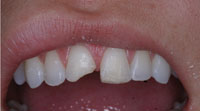|
INTRODUCTION
Myths are often attached to new practices (using new techniques and materials) that replace those that have become unfounded when cycles change and new technology and new materials become available that totally, not gradually, alter the landscape and, therefore, the best practice of the day. Often, new practices scare professionals and others who don’t want to make changes. So, old ideas are held in place by professional schools, professional practices, laboratory technicians, and journal articles that often continue to discuss “traditional preps” for veneers done by habit, experience, and convention.
Language about the new practice, often captured in slogans or stock phrases, is generated and then repeated. The use and power of such slogans are well-known in the arena of political campaigns: “no prep, no good.” (Notice how this idea is “suspended” in language, and is therefore “held” in place.)
Some Background on Replacement Technology
First, let’s clear up a misconception: Many articles in journals and speakers on aesthetic dentistry, refer to “traditional veneers” as those that involve preparations; that is, prepping to the degree that tooth structure is removed as “traditionally/conventionally” done today. Historically, one must remember that original porcelain veneers were meant to be “prepless” (without preparation). It is a myth that the original version of the traditional veneer included the amount of preparation as we observe as the norm today, and that no-prep veneers are a “new” trend.
When I began practice at the end of the 1960s, the only way to improve a smile was to do it with full-coverage crowns, an aggressive approach at best, and one that was only used by dentists who could justify the destruction of a lot of healthy tooth structure in the name of aesthetics.
When “cosmetic bonding” was introduced, the more conservative-minded dentists used the material to aesthetically improve a smile. I remember laboratory-fabricated composite veneers that were en vogue for a very short time, as they were quickly replaced by porcelain veneers. Cerinate porcelain veneers released in the 1980s by Dr. Robert Ibsen, were meant to be done with no preparation, and I did many of these in the 1980s. However, when we wanted to improve the aesthetics on larger or misaligned teeth, we developed “veneer preps” that would enhance the aesthetics of these formerly “prepless” porcelain veneers.
With time, veneer prep design “matured,” and as dentists and dental technicians demanded better aesthetic results, the preps grew more and more aggressive, often removing all the enamel, shortening the teeth, sometimes wrapping over the incisal edges and even opening the interproximal contacts. We can look at many veneer articles in journals and find, in some cases, aggressive veneer preparations are practically impossible to distinguish from nearly full-crown preparations!
TO PREP OR NOT TO PREP
My philosophy from day one has been and is: It is always desirable to preserve natural tooth structure for our patients, whenever it is possible.
—Such a benign-sounding word, but its meaning is anything but benign. Prep in this context means drilling or shaving, grinding down to a depth that leaves little behind, making the result irreversible.
The term “no-prep veneers” generally refers to very thin shells of porcelain that are designed to cover or replace enamel.
Top Reasons We Believe We Still Have to Prep
First, dental schools, in general, and most aesthetic teachers/gurus in particular, teach prepped veneers. They advocate reducing the labial of the tooth, rounding it off, removing the proximal line angles, shortening the incisal edge, and bonding to enamel and/or dentin. This is what many dental students are taught. Fortunately, in the author’s opinion and that of others, this trend is gradually changing. At a recent meeting, a speaker recently noted that he no longer “tells [attendees/students] to drill as much as I used to.” It’s how we were taught, but the cycle of new technology and materials is responsible for a sea of change in our procedures. We now have materials and techniques available to us that eliminate the need to prep.
Second, dental laboratory technicians want more “room” to create their restorations. Instructions from the laboratory may dictate to the professional the amount of room necessary to create aesthetically pleasing porcelain veneers. Again, this is usually determined without the dental technician being able to personally and visually evaluate the patient with the doctor.
Third, habit and experience keep this idea for prepping (more often than not) perpetuated. Many dentists still believe in “remove and replace” dentistry. Some say there are times you have to prep, such as in a case of severe misalignment. This may be the case, but, with the new materials, you no longer have to prepare the tooth to the previous depth, and a shoulder or chamfer is no longer needed at the gumline unless the presence of caries or a previous fracture dictates it. Also, I have found that a supragingival margin with a feather edge (similar to a feather edge design that is used with gold) will not cause a periodontal reaction. Of course, orthodontics as an adjunct to veneers is always a good option for severe misalignment.
Seven Reasons to Not Prep!
- The failure rate of dentin-bonded veneers is much greater than those that are bonded to enamel. It is always optimal to bond veneers to enamel for both strength and long-term durability. Bonding porcelain to enamel creates a solid and secure bond, compared with bonding porcelain to dentin. This bond, when the techniques are done right, is even stronger than nature’s bond of enamel to dentin.
- Prepping is sometimes done to compensate for material deficiencies. Pure and simple: It is the porcelain that makes the difference. For example, in the case of the Lumineers (DenMat) system and philosophy, the objective is to provide a safe and wear-, stress-, and microleakage-resistant, restoration that is highly aesthetic and that has been shown to last more than 20 years…all without preparation!
- You may have an aesthetically beautiful result with a subgingival prepped subgingival margin, but patients will have a higher likelihood of gingival recession than with a supragingival margin. Additionally, with subgingival prepped veneers, there is a higher likelihood for other untoward periodontal reactions.
- Even in cases of minimal prep, with slight overlaps and spacing for which some contouring should be done, one still rarely has to touch dentin or use anesthesia.
- Postoperative sensitivity will never occur when intraoperative procedures have been performed without anesthesia, if the patient feels no sensitivity during the recontouring of one’s teeth. (Once a tooth has been anesthetized, it is impossible to distinguish between sensitive and nonsensitive tooth structure.) It follows that the need for endodontic therapy will simply not occur as a result of the no-prep procedure and subsequent restoration. Because no-prep veneer procedures are a noninvasive, pain-free procedure, excitement about the procedure can spread among patients.
- In this procedure requiring 2 patient appointments, temporaries are unnecessary in no-prep veneers, so the procedure takes much less chair time than those requiring preparations with the associated fabrication and then removal time needed for provisionals. And by experience, I know how making, maintaining, and removing veneer temporaries can be quite stressful and time-consuming.
- Cosmetic contouring that removes only nonsensitive tooth structure without placing any predetermined margins, creating a foundation suitable for placing no-prep veneers and creating optimal aesthetics, is the most conservative basis for beginning to put patients into porcelain veneers. In ideal recontouring cases, patients leave the office looking better than before the appointment began, even when their veneers have not yet been delivered. And they actually could remain without their veneers forever. This is how we used to improve smiles long before the ability of bonding to tooth structure existed.
Myth—(Here’s a core misperception referred to earlier)What are called “traditional preps” (notice the language here; “traditional” is very comforting when speaking of procedures) originally did not involve the amount of tooth preparation that is used now. It is a myth that the original version of the traditional veneer included such a preparation and that no-prep veneers are considered a “new” trend.
Again, “traditional” preps were originally no-preps. They were only changed later to include prepping because the veneers in use at that time were either found to be too thick or the tooth too prominent. Tooth surface was removed to compensate for the thickness so that veneers could be placed on large teeth, not just used exclusively on small or lingually positioned teeth or on dentitions with diastemata. In other words, the full-prep technique was developed to compensate for the weak porcelain available to dentists at the time and for limitations in the bonding materials, such as the ability to control or mask color. In fact, some of the current resistance to prepless veneers arises in part from the assumption that the limitations that existed at that time still exist. However, most of those limitations are no longer valid.
In the mid 1980s, when Cerinate Smile Design Studios introduced porcelain veneers, their motivation for that development was to enable restoration of anterior teeth with porcelain (bonded with a composite restorative material) without a preparation. That was the original “traditional” veneer! It essentially replaced direct bonding, which at the time, was the only alternative to preparing teeth to create better aesthetics.
Let’s now look briefly at a case on a young girl, where I believe the use of traditional preparations in the process of the placement of porcelain veneers would have been unnecessary to achieve patient satisfaction.
CASE REPORT
Christine is a young patient who just had her orthodontic bands removed, and was sent to our office to “fix the 2 front bonded broken teeth with porcelain veneers” (Figures 1 and 2).
When we examined the arch, we noticed that teeth Nos. 7 through 10 were approximately 0.75 mm lingual to the arch, while the cuspids through the molars filled the buccal corridor nicely. This necessitated the use of 4 anterior veneers. In my belief system, I feel that patients like Christine are better served with prepless veneers. In situations like this, on young people, I offer no other plan.
We used Cerinate II (DenMat) porcelain, shade 030 with 50% translucency with incisal shading and bonded it with a neutrally-shaded composite resin cement (Ultra-Bond Plus [DenMat]). The 4 maxillary anteriors were aligned perfectly (Figure 3) and the patient was very pleased with her new smile (Figure 4). If I had veneered only the 2 maxillary centrals, I would have had to prepare them in order to align them with the lateral incisors.
CLOSING COMMENTS
In the author’s opinion, the case presented in this article demonstrates the use of no-prep veneers as the preferred minimally invasive option, and one that took into account all the best interests of our patient. Please review the photographs closely. If you think that you would have done preparations in this case, please reconsider and know that there are many more situations for no-prep veneers than one might think.
Dr. Freydberg, a full-time practitioner, is a 1968 graduate of the University of Illinois College of Dentistry and receiving their “Most Distinguished Alumni Award” in 2004. He is a Fellow of the AGD, the International College of Dentists, the American College of Dentists, and the International Academy for Dental-Facial Esthetics. He has lectured and published on the subject of computerization of the clinical and management aspects of the dental practice. He is also a consultant to the ADA Council on Dental Practice. Dr. Freydberg, an active member of the Chicago Dental Society, can be reached via e-mail at the address barry@hitech2thdoc.com, or at the Web site hitech2thdoc.com.
Disclosure: Dr. Freydberg receives honoraria from DenMat to teach courses on no-prep veneers. He has no financial ties to any other products or companies mentioned in this article.
{rscomments on}







